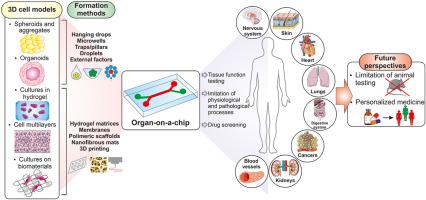当前位置:
X-MOL 学术
›
Anal. Chim. Acta
›
论文详情
Our official English website, www.x-mol.net, welcomes your feedback! (Note: you will need to create a separate account there.)
Review: 3D cell models for organ-on-a-chip applications
Analytica Chimica Acta ( IF 6.2 ) Pub Date : 2024-02-28 , DOI: 10.1016/j.aca.2024.342413 Agnieszka Żuchowska , Patrycja Baranowska , Magdalena Flont , Zbigniew Brzózka , Elżbieta Jastrzębska
Analytica Chimica Acta ( IF 6.2 ) Pub Date : 2024-02-28 , DOI: 10.1016/j.aca.2024.342413 Agnieszka Żuchowska , Patrycja Baranowska , Magdalena Flont , Zbigniew Brzózka , Elżbieta Jastrzębska

|
Two-dimensional (2D) cultures do not fully reflect the human organs' physiology and the real effectiveness of the used therapy. Therefore, three-dimensional (3D) models are increasingly used in bioanalytical science. Organ-on-a-chip systems are used to obtain cellular models, better reflecting the human body's characteristics and allowing us to obtain more reliable results than standard preclinical models. Such 3D models can be used to understand the behavior of tissues/organs in response to selected biophysical and biochemical factors, pathological conditions (the mechanisms of their formation), drug screening, or inter-organ interactions. This review characterizes 3D models obtained in microfluidic systems. These include spheroids/aggregates, hydrogel cultures, multilayers, organoids, or cultures on biomaterials. Next, the methods of formation of different 3D cultures in Organ-on-a-chip systems are presented, and examples of such Organ-on-a-chip systems are discussed. Finally, current applications of 3D cell-on-a-chip systems and future perspectives are covered.
中文翻译:

评论:用于芯片器官应用的 3D 细胞模型
二维 (2D) 培养不能完全反映人体器官的生理学和所用疗法的真实有效性。因此,三维(3D)模型越来越多地应用于生物分析科学中。器官芯片系统用于获得细胞模型,更好地反映人体特征,使我们能够获得比标准临床前模型更可靠的结果。此类 3D 模型可用于了解组织/器官对选定的生物物理和生化因素、病理条件(其形成机制)、药物筛选或器官间相互作用的反应行为。本综述描述了微流体系统中获得的 3D 模型的特征。这些包括球体/聚集体、水凝胶培养物、多层、类器官或生物材料上的培养物。接下来,介绍了在芯片器官系统中形成不同 3D 培养物的方法,并讨论了此类器官芯片系统的示例。最后,介绍了 3D 片上单元系统的当前应用和未来前景。
更新日期:2024-02-28
中文翻译:

评论:用于芯片器官应用的 3D 细胞模型
二维 (2D) 培养不能完全反映人体器官的生理学和所用疗法的真实有效性。因此,三维(3D)模型越来越多地应用于生物分析科学中。器官芯片系统用于获得细胞模型,更好地反映人体特征,使我们能够获得比标准临床前模型更可靠的结果。此类 3D 模型可用于了解组织/器官对选定的生物物理和生化因素、病理条件(其形成机制)、药物筛选或器官间相互作用的反应行为。本综述描述了微流体系统中获得的 3D 模型的特征。这些包括球体/聚集体、水凝胶培养物、多层、类器官或生物材料上的培养物。接下来,介绍了在芯片器官系统中形成不同 3D 培养物的方法,并讨论了此类器官芯片系统的示例。最后,介绍了 3D 片上单元系统的当前应用和未来前景。



























 京公网安备 11010802027423号
京公网安备 11010802027423号